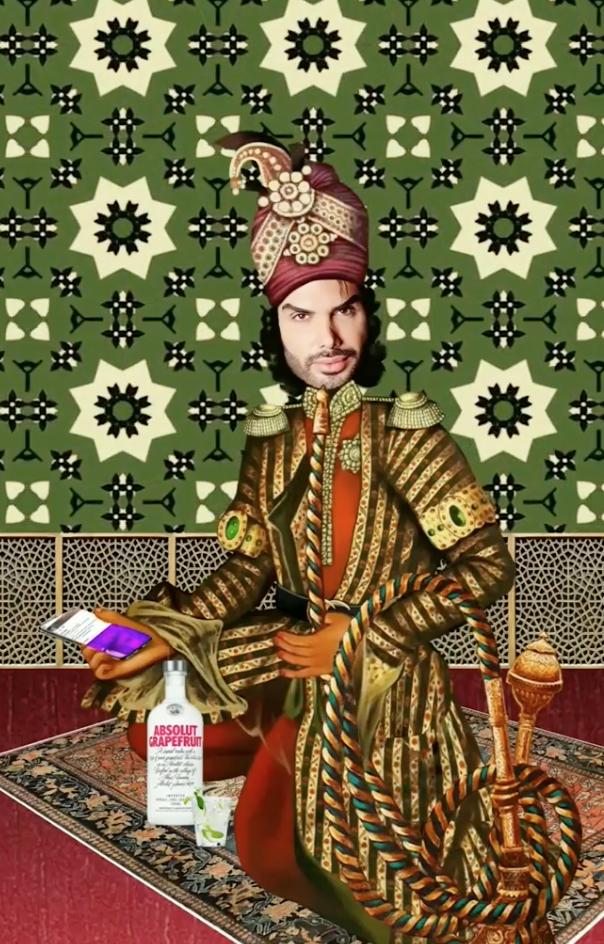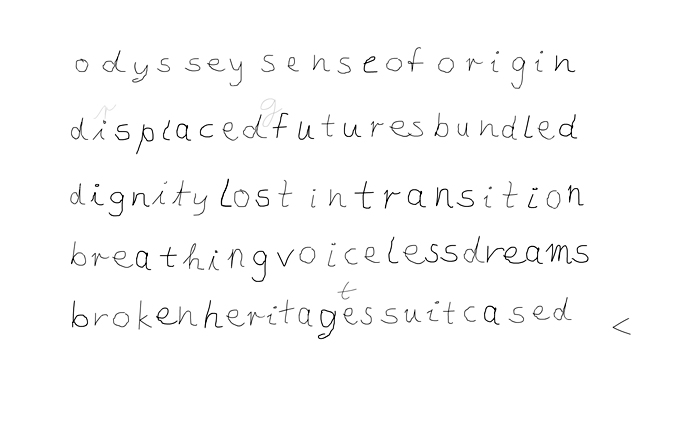The Station (2020) is an interactive piece that takes place after the end of the world in a space station. The Station is based off of the Myth of Sisyphus and ties into the idea of nostalgia as a weapon of ideology. Two A.I. guides, Sabrina and Alex, accompany the viewer through the space station. The piece reveals forty three rooms designed to make the viewer feel nostalgia for past eras and the future.
:::
DigA: This simulation includes two A.I.s that have opinions on the topics associated with some of these rooms. For example, in the 1950s room, the A.I. Alex discusses archaeology on Earth, and goes on to say he does not think archaeology was an interesting field of study. The irony here is The Station itself is pulling together archaeological artifacts in each room. How did you decide what to salvage from Earth’s memories and how many of your own opinions and experiences are tied into this piece?
Vi Trinh: There is a lot of disconnect between what the A.I. say and reality, it speaks to the delusion of the creators of the space station. The conceit of the piece is built around the choices of the super-rich who built the space station. What does a space built by disaster capitalists who used their riches only for their self-preservation and comfort look like? What the space station mimics from earth and brings onto the space station is entirely based on this fiction. They embody an extreme American nationalism, white supremacy, and environmental racism. When deciding what to include in each room I had to put it through that filter. Even more importantly, I chose aesthetics based on the nostalgia of a future, future. There are three categories of nostalgia that I put in the project. The first is major periods of history from Egypt through the Victorian era, which speaks to socio-economic structures and aesthetic nostalgia patterns being present through time and space; the second is the 1910s through the 2010s which speaks to more modern commercialized nostalgia; the third nostalgia is the future’s nostalgia, the nostalgia to people living in the space station is the earth, its weather, its landscapes, and its ecosystems. From these categories I tried to simplify and idealize these periods to its most extreme.
The fact that the entire piece takes place in a post-apocalyptic future means that in many ways all of it is my own opinion, because there’s no way for it to be fact…yet (and I hope it never becomes fact). But I base it in realism and patterns that are present now so that viewers can follow the chain of logic. My research began with my own observations, however I tried to limit my voice in the piece so that it doesn’t distract from the overall message, which is why most of the narration spoken by the A.I. and are quotes pulled from other authors, philosophers, and artists.
DigA: Your art reflects current environmental issues. Some of the most interesting rooms within The Station are those that touch on the fact that humanity had to move from Earth up to this space station, as the Earth was no longer sustainable for human life. Can you go more into detail about the hypothetical reason humans had to leave in this simulation?
VT: In the piece the family refers to the end of the world as “the disaster.” In the fiction of the universe, the end of the world came about from a series of events. First, global warming essentially destroyed ecosystems, and the global current was disrupted creating perma-frost in the top and bottom quarters of the planet, which led to the equator becoming one massive desert. Due to the burdens this placed on governments, war broke out over the last arable land, and the last fresh water untainted by pollution, and then everyone launched nuclear weapons essentially destroying what was left of the Earth. The space station was originally one of those satellites that could launch ballistic missiles and then was refurbished by the family.
DigA: Your previous piece, Escape, also featured in Digital America, focuses on an apocalyptic state where humanity has to move to a bunker and leave behind their lives and possessions. What do you think are some of the most important takeaways from human civilization that you like to include in your work? How did you narrow down your curated list and what are some aspects of human life you feel are integral to remember through the development of the human race?
VT: This series of bunker pieces are satirical and critical of current power structures and each one focuses on different aspects of society. It’s less about humanity as a whole but taking slices of it, mostly of the bad side of humanity. I give myself defined guidelines and rules to follow when creating each bunker. Much like creating a character backstory, it has to remain consistent. I give myself such stringent and somewhat niche topics and themes to discuss, because I don’t feel like I can speak on humanity through the entirety of time, or civilization, or even on other cultures with any authority. I can’t speak on individuals, only patterns. With my work, which so far has focused on flaws, flaws hidden within a veneer of pleasing aesthetics, I don’t think of these aspects as integral or memorable, because they shouldn’t be. These pieces focus on greed, self-delusion, and pride, I don’t want them to be immortalized. I want them to be fixed, to be checked and balanced.
DigA: The rooms do not follow a chronological pattern as you move through the “station.” What was the reasoning behind this decision, and how did you decide the layout of these rooms? Do you have a schematic or hidden map for this simulation?
VT: As I discussed earlier there are three categories, Egypt through the Victorian era, 1910 through 2010, and nature. I alternated them thinking about viewer experience, and to prime the viewer to think about the theme rather than a tour through art history. The layout of The Station is extremely directional so although the viewer is able to interact and make choices on where to go, ultimately those choices are meaningless because they’re all going to the same place. I do have a secret map of the space station, which I’ll be releasing in the guidebook I’m making for the piece that includes all the narration paired with the rooms, the map, sources, and commentary on each room and the decisions involved in making it.
DigA: As one may notice while navigating The Station, the rooms and A.I.s have very specific details they like to include in order to convey the importance of each era or place. Who or what do you feel is represented in this piece? Are there some people/places/things you intentionally left out? What is the unsaid bias that is central to the construction of this piece?
VT: I intentionally left out non-western cultures, because the station is western-centric, in the history portions they collapse multiple non-western cultures’ histories into one image. Think of every horrible bias a person can have and add it to the list. The biases that you find in the piece are represented by the two A.I. Alex and Sabrina, who are supposed to be infallible entities, but they were built by people with biases and now have those biases built in. When they speak, they become the stand-ins to exposing the psychology of the people who built the station. They use quotations out of context and spin it to justify their own behavior and beliefs. They prime the viewer by describing what the room is, they add legitimacy by quoting others, and then they add commentary in order to further their own propaganda.
DigA: You mentioned in a separate interview that the last installation of the series will include an Atlantian premise. Can you tell us anything about what to expect in this upcoming piece? What made you choose Atlantis to end the series?
VT: Atlantis is the last piece of the Bunker Series. So far, the pieces have taken place underground, and in space, it only seemed right to finish underwater. However, breaking from the pattern of the first two, Atlantis will be a more positive take on a post-post-apocalyptic society. While Escape was inspired by plato’s cave, and The Station was based on the myth of Sisyphus, Atlantis will be based on Plato’s version of Atlantis mostly taking cues off of his description of it, as well as his message to Athenians against hubris and greed. It will also be a 3D programmed experience in order to allow the viewer more control over the experience. I wanted to end the series on a positive note, because it would be unfair for me to create so much pessimistic work on the future without also acknowledging the positive side of humanity.
DigA: And finally, what was the inspiration behind this piece?
VT: I was inspired by the myth of Sisyphus and its multiple interpretations, how the space station would revolve around the earth mimicking the movement of Sisyphus, and how some of the interpretations ignore his crimes in order to justify different messages. All of that ties into nostalgia where like Sisyphus it retreads the same path over and over again.
Check out The Station here.
Check out a response to The Station.
See Escape, the first piece of the Bunker Series.
:::

Vi Trinh specializes in digital media that examines the relationship between social patterns, power dynamics, and ecology and technology, primary work includes Escape and The Station. She graduated from the University of Richmond in 2019 with a B.A. in Visual and Media Arts Practice & Leadership and is currently the Post Graduate Resident at the Torpedo Factory Art Center. Exhibition History includes, Digital U: Extreme Views pt. 2, Art Gene, Cumbria, England. △: Senior Thesis Exhibition, Harnett Museum of Art, Richmond, VA, featuring 1% for the 1% and Escape.



